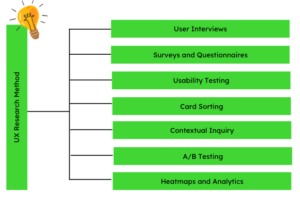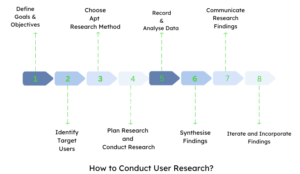What is UX Research? How to Conduct UX Research?
UX research is about creating flawless designs for intuitive and user-centric experiences. And for this delightful experience for the customers, the research goes around user behaviour, their preferences, and pain points.
What is UX research?
UX research, short for User Experience research, refers to systematically studying and understanding users’ behaviours, needs, and preferences to design and improve products, services, or systems that provide a positive user experience. It involves gathering user insights and feedback through various qualitative and quantitative research methods.

The main goal of UX research is to deeply understand the users, how they remain motivated, and how do they interact with a product or service.
After the UX research, designers and developers can take informed decisions to create user-centred designs.
UX research methods can include:

User interviews:
Conducting one-on-one interviews with users to understand their needs, experiences, and pain points.
Surveys and questionnaires:
Collecting quantitative data from a larger user group to gather insights and measure user satisfaction.
Usability testing:
Observing users as they interact with a prototype or a live product to identify usability issues and gather feedback.
Card sorting:
Organizing and categorising information by asking users to group related items, helping designers create intuitive information architectures.
Contextual inquiry:
Finding out how the users use the product or service in real-life situations implies the contextual inquiry. It is important to understand to find how they will use the app.
A/B testing:
Always test the alternative based on specific metrics and user experience. Identify which one will work better is important to finalise the design.
Heatmaps and Analytics:
Analysing user behaviour and interactions through tools like heatmaps, click tracking and user journey analysis.
The insights help refine the design process and features by addressing usability issues. By prioritising user needs and expectations, organisations can create products and services that are intuitive, effective, and enjoyable to use.
Read: What is UI/UX Design?
Why are usability studies important for UX research?
Usability studies are crucial for UX research because they provide valuable insights into how users interact with a product or service and help identify areas for improvement. Here are some reasons why usability studies are essential:

Identify usability issues:
Usability studies allow researchers to observe users navigating a product or performing specific tasks. This helps identify usability issues, pain points, or obstacles users may encounter. By understanding these challenges, designers can make informed decisions to improve the user experience.
Validate design decisions:
Usability studies provide concrete evidence to validate design choices. First observe how users interact with a prototype or a live product, finalise the design and see whether it meets users’ needs, expectations, and mental models.
Improve user satisfaction:
Usability studies help gauge user satisfaction by collecting feedback on their experience. Aim is to satisfy the users by eliminating the points that are frustrating for them. And when you have less frustrated users, you have higher user engagement, loyalty, and positive word-of-mouth.
Optimise task efficiency:
Usability studies help identify inefficiencies in completing tasks within a product or service. By observing users’ interactions and the time taken to complete tasks, researchers can uncover bottlenecks or confusing elements that hinder task efficiency. This information enables designers to streamline processes and enhance productivity for users.
Enhance accessibility and inclusivity:
Usability studies shed light on accessibility issues and ensure that a product or service is usable by a diverse range of users, including those with disabilities. By observing users with different abilities, researchers can identify barriers and make necessary adaptations to ensure inclusivity.
Iterative design improvement:
Usability studies are often conducted iteratively throughout the design process. Researchers gather feedback, make design adjustments, and conduct subsequent usability studies to validate the effectiveness of the changes. This iterative approach helps refine the design and ensures it aligns with user needs and preferences.
Also Read: What is UX Research?
How to conduct user research?
Performing user research in UX involves a systematic approach to gathering insights about users and their needs. Here are the key steps to conduct user research in UX:

Define research goals:
Start by clearly defining the research objectives. Determine the purpose and the scope of the research and identify the questions that will give you answers for your goals.
Identify target users:
Define your research’s target audience or user group. Consider demographics, characteristics, and relevant user segments. This helps ensure you gather insights from the people using your product or service.
Choose appropriate research methods:
Select the research methods that align with your goals and user group. Common methods include user interviews, surveys, usability testing, card sorting, and contextual inquiry. Each method has strengths and limitations, so choose the ones that best suit your research objectives.
Plan research logistics:
Create a research plan that outlines the timeline, resources needed, and logistics. Determine how many participants you need for each research method and develop a recruitment strategy to find suitable participants. Decide on the tools and technologies required for data collection and analysis.
Conduct user research sessions:
Execute the research plan by conducting the user research sessions. Depending on the chosen methods, this could involve conducting interviews, facilitating usability tests, administering surveys, or observing users in their natural environment. Follow a structured approach, ask open-ended questions, and encourage participants to share their thoughts and experiences.
Record and analyse data:
During the research sessions, record data through note-taking, audio or video recordings, or digital tools. Once the sessions are completed, analyse the collected data. Look for patterns, themes, and insights from the responses and observations. Use qualitative and quantitative analysis techniques to make sense of the data.
Synthesise and interpret findings:
Synthesise the research findings by organising and categorising the data. Identify common themes, pain points, user needs, and preferences. Interpret the findings in the context of your research goals and user personas. This step helps you deeply understand the users and their behaviours.
Communicate research findings:
Prepare a comprehensive report or presentation that communicates the research findings to stakeholders, designers, and developers. Use visual aids, storytelling techniques, and data-driven insights to convey user research results effectively. Ensure that the findings are actionable and can guide decision-making in the design process.
Iterate and incorporate findings:
User research is an iterative process. Use the insights gained from the research to inform the design decisions. Collaborate with designers and developers to incorporate the research findings into the product or service. Continuously evaluate and refine the design based on user feedback and iterate as needed.
Conclusion
UX research is a systematic process of understanding users’ behaviours and needs to design and improve products or services. It involves gathering insights through interviews, surveys, and usability testing. UX research aims to create user-centred designs that provide a positive user experience. For effective UX research and design, contact us at hello[at]noboruworld.com.
FAQ
Why are user interviews important for UX research?
User interviews are important for UX research because:
- Gain a deep understanding of user needs, motivations, and goals.
- Obtain subjective feedback and insights about user experiences.
- Gather contextual information about users’ real-life use cases.
- Identify unmet needs and opportunities for innovation.
- Foster empathy and develop user personas for user-centred design.
- Support iterative design improvement through user feedback.
What are common user research questions?
Some of the common research questions that you can also refer to include:
- What are users’ pain points or challenges when using similar products/services?
- How do users currently solve the problem the product/service aims to address?
- How do users perceive the value and benefits of the product/service?
- How does the product/service fit into users’ workflows or routines?
- What are the demographic and psychographic characteristics of the target user group?
- How satisfied are users with their current solutions, and what improvements do they desire?
- How do users discover, learn about, and acquire new products/services in the domain?
What is UX research?
UX research systematically studies and understands users’ behaviours, needs, and preferences to design and improve user-centred products or services.
Why is UX research important?
UX research is important because it helps designers make informed decisions based on user insights, improves user satisfaction, identifies usability issues, and enhances the overall user experience.
What methods are used in UX research?
UX research methods include user interviews, surveys, usability testing, card sorting, contextual inquiry, A/B testing, and analysing user behaviour through heatmaps and analytics.
How does UX research inform the design process?
UX research provides valuable insights into user needs, preferences, and behaviours, which guide designers in creating user-centred designs and refining features to meet user expectations.
When should UX research be conducted?
UX research should be conducted throughout the design process, from the early stages of ideation to post-launch evaluations. Iterative research helps gather feedback, validate design decisions, and make continuous improvements.
How can I get started with UX research?
When you start with UX research, define your research goals, identify your target users, zero down to research methods, conduct research sessions, analyse the data, and incorporate the findings into your design process.



